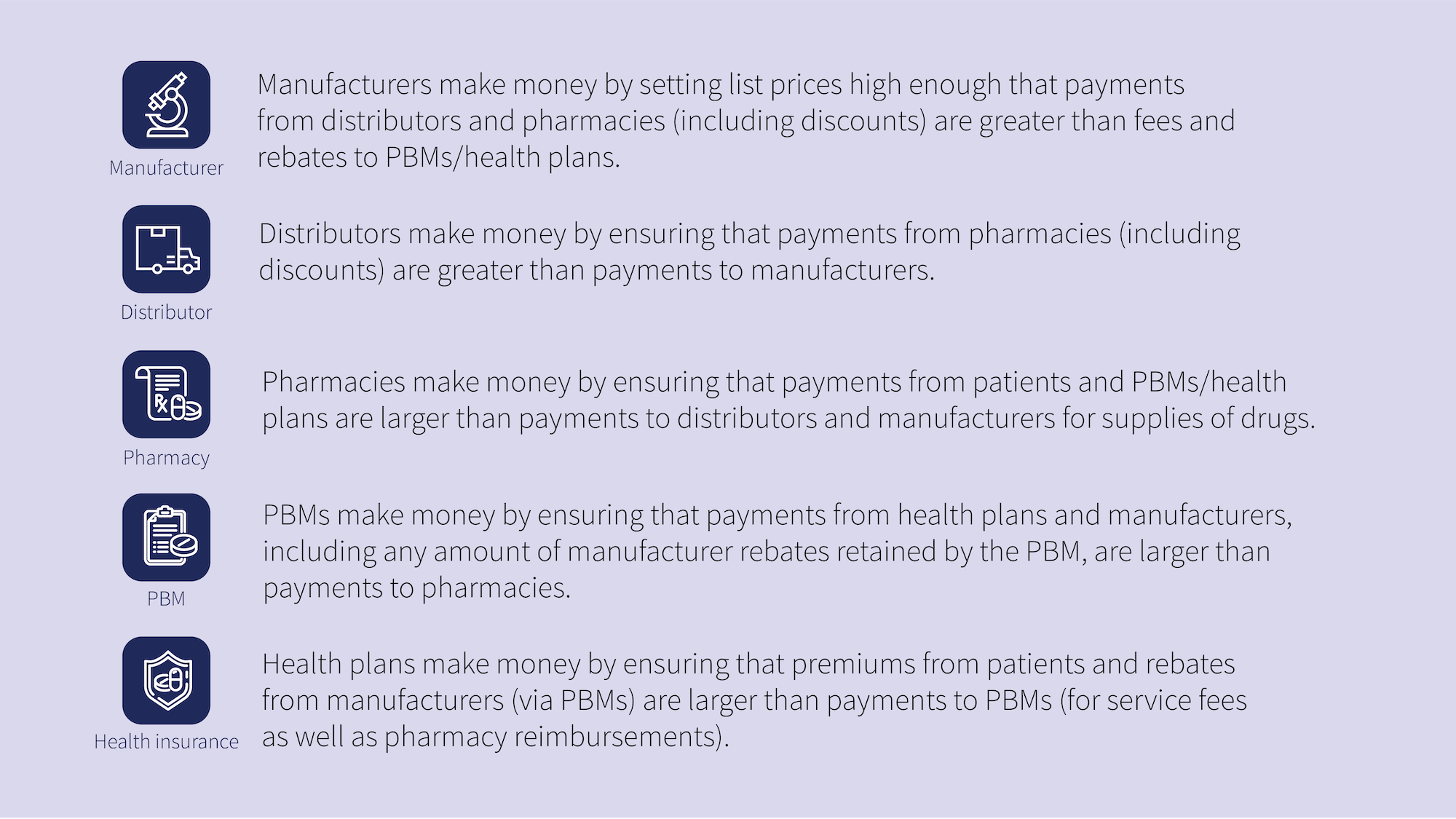
Written by Derek Monson
September 4, 2020
This is part 3 of an ongoing series seeking to describe and decode the prescription drug market for policymakers and the public so we can understand the price we pay at the pharmacy. In previous parts, we introduced the series and offered a review of the players in the prescription drug market. In this part, we track how money flows through the market and how market players make money, ultimately determining the price we pay at the pharmacy.
In addition to the basic economic role of players in the prescription drug market, following the flow of money and learning how each player makes money is important for understanding what you pay at the pharmacy. Decisions that prescription drug market players make to improve their cash flow can often directly impact a patient’s out-of-pocket cost for prescription drugs.
There are two money flows necessary for us to examine – one on the supply side and one on the demand side.
Supply Side
Money is constantly moving between the various players in the prescription drug market, so there really is no chronological “beginning” to following the money. But conceptually, it can be helpful to view the sale of a shipment of drugs by a drug manufacturer to a distributor as the beginning. The distributors pay the list price for the drugs, often referred to as the “wholesale acquisition cost,” or WAC. The distributor can receive discounts on the list price based on the size of the order and prompt payment for the drugs.
The pharmacy then pays the distributor for delivery of a particular amount of a prescription drug that it will sell to patients. In limited instances, pharmacies can pay manufacturers directly for a shipment of drugs. The pharmacy pays the distributor a markup on what the distributor paid the manufacturer, but that payment is based on the manufacturer list price or WAC, just like the distributor’s payment to the drug manufacturer. The pharmacy can also receive discounts for purchasing a larger supply of the drug.

Demand Side
The flow of money on the demand side is more complicated. When a patient purchases a drug at the pharmacy, paying either a cash price for a prescription or an out-of-pocket cost determined by the patient’s coverage in their health plan, a multi-stage process of payments begins to flow.
A patient’s purchase of a prescription under their health plan triggers a payment to the pharmacy by the pharmacy benefit manager (PBM) on behalf of the health plan. This payment is an amount previously negotiated by the PBM and the pharmacy for that particular prescription drug. The health plan/PBM-to-pharmacy payment is most often based on three factors:
- a discounted manufacturer’s list price,
- a dispensing fee for the pharmacy, and
- the out-of-pocket payment to the pharmacy from the patient (influenced by the health plan formulary)
The PBM submits claims to the drug manufacturer for how much drug was dispensed to patients under their health plan, and then receives a rebate payment plus a service fee from the manufacturer. The size of the rebate is an amount determined in a previous negotiation between the PBM (on the health plan’s behalf) and the manufacturer, which also determines where a drug will fall on the health plan’s formulary. The formulary decision impacts the price a patient pays at the pharmacy by influencing things like patient co-pays or co-insurance for a particular prescription. The PBM passes all or some of the rebate onto the health plan, depending on the contract between the PBM and the health plan, and is paid a fee by the health plan for its services.
The Profits
Based on the above cash flows, each player in the prescription drug market has a basic way to make a profit. Each has additional ways to produce revenue to ensure profitability (e.g., distributors shipping more than just prescription drugs) but knowing the basic ways for the players to be profitable in their prescription drug business illuminates the financial pressures they exist under.

By following the money in the prescription drug market and knowing how the players profit, we can move toward a firmer understanding of how these market exchanges determine prices at the pharmacy for patients. That will be the subject of the next installment.
Prescription Drugs 101: The 6 things that determine the price we pay
More Insights
Read More
How transparent are school districts about curriculum?
Utah districts don’t need to wait for legislation to be transparent – many have sought to be transparent on their own. District leaders interested in this reform can do several things right away.
What you need to know about the upcoming state party conventions
The two major political parties are about to hold their state conventions. Here’s what you need to know.
Here’s why the First Amendment’s religion clauses are not in conflict
Some suggest there is a tension between protection for the free exercise of religion and the prohibition on the establishment of religion. But a better take is to see the two clauses as congruent.


